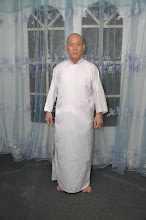第 十 四 章
視 之 不 見 名 曰 夷 , 聽 之 不 聞 名 曰 希 。 搏 之 不 得 名 曰 微 。 此 三 者 不 可 致 詰 , 故 混 而 為 一 。 其 上 不 皦 , 其 下 不 昧 , 繩 繩 兮 不 可 名 , 復 歸 於 無 物 。 是 謂 無 狀 之 狀 , 無 象 之 象 , 是 謂 惚 恍 。 迎 之 不 見 其 首 , 隨 之 不 見 其 後 。 執 古 之 道 , 以 御 今 之 有 , 能 知 古 始 , 是 名 道 紀 。
Look at Tao, you see nothing; this is called elusive. Use ear to hear Tao, you hear nothing; this is called rare. Trying to grasp Tao, you get nothing; this is called subtle. These 3 statements are beyond all resolution, therefore we mix them into One. Above One, it is not luminous; below One there is no darkness. To a state that is nameless, a return to the period before nothingness (missing 'wu' in above image). It is called a form without form and shape with nothingness. This is called confused vagueness. From the front you cannot see Its head; from the rear you cannot see Its back. Getting hold of the ancient Tao, treat It as your precious possession. You can then know ancient beginning that is called Tao's characteristics or Way of Tao.
Contemplate on these sentences.
It is to fully having faith with the One inside you. Focusing on it with nasal gaze, the ancient art of communion with the Self. See http://sg.geocities.com/alex_kew/comment/taoistyoga.html .

No comments:
Post a Comment